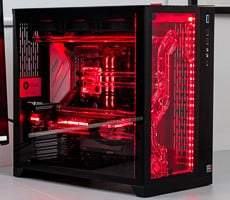Sound BlasterX AE-5 Review: An Uncompromising Gaming Sound Card For Audiophiles
Creative Labs was instrumental in evolving PC audio with notable products, like the Sound Blaster 16, AWE 32, AWE64, Live!, Audigy, X-Fi, and Extigy, and algorithms like EAX technology. Most of its competitors through the last three decades, like Yamaha, ESS, Turtle Beach, Auzentech and M-Audio, evolved their product line-ups or faded into obscurity. There were acquisitions of Aureal and Sensaura technologies that further boosted Creative's technology portfolio, too. Sound cards seem passé nowadays, as motherboard manufacturers hop up high-definition audio codecs with higher quality op-amps, capacitors, shielding and S/PDIF outputs, that make discrete sound cards a harder sell. But despite all the optimizations and tweaks to on-board audio, there’s only so much you can do with cost-conscious audio codecs.
Creative Labs recognizes the shortcomings of on-board audio and offers a variety of USB DAC’s, like the Sound Blaster E5, G5, and X7 to provide higher quality audio output, but its internal sound card lineup has been a bit stagnant. Heck, the last time we reviewed a Sound Blaster card was in 2014 with the ZxR, and we haven’t seen any new sound card releases since the ASUS STRIX RAID DLX in 2015, until now. Dubbed the Sound BlasterX AE-5, the latest PCIe sound card from Creative Labs comes with all the gamer necessities, including a high-quality DAC, dedicated headphone amp, sleek looks, and RGB lighting controls.
|
| Interface |
PCI Express x1
|
| Dynamic Range | 122 dB (Stereo, DAC) |
| Total Harmonic Distortion (THD+N) |
0.00032% (Stereo, DAC)
|
| Sampling Rate (DSP Playback) |
16-bit / 16, 44.1, 48, 88.2, 96 kHz
24-bit / 44.1, 48, 88.2, 96 kHz
32-bit / 44.1, 48, 88.2, 96 kHz
|
| Sampling Rate (Direct Mode Playback) |
16-bit / 48, 96, 192, 384 kHz
24-bit / 48, 96, 192, 384 kHz
32-bit / 48, 96, 192, 384 kHz
|
| Sampling Rate (Recording) | 16-bit / 16, 44.1, 48, 88.2, 96 kHz 24-bit / 44.1, 48, 88.2, 96 kHz |
| Headphone Amp |
Supports 16 - 600 ohms impedance
|
| Connectivity |
1 x 1/8-inch Microphone / line-in
1 x 1/8-inch Headphone / headset out (Xamp)
1 x 1/8-inch Front out
1 x 1/8-inch Rear out
1 x 1/8-inch Center / Sub out
1 x Optical S/PDIF out
1 x HD Audio front panel header
1 x RGB LED header (supports 5V RGB strips)
|
| Power | 1 x MOLEX (+5V for Aurora lighting) (optional) |
| Pricing |
At the heart of the Sound BlasterX AE-5 is Creative Labs’ in-house Sound Core3D digital signal processor (DSP) that’s also found in the previous Recon3D and Z-series. But the Sound Core3D implementation isn’t the same as the previous generation cards despite being the same silicon. Creative Labs claims the Sound Core3D was engineered with emphasis on future-proofing so it’s programmed differently in the AE-5. Differences include support for 44.1 and 88.2 kHz playback in Direct Mode and virtual 7.1 support. The volume control on the AE-5 is directly mapped to the DAC volume too, so there’s no fiddling with an audio mixer to ensure you’re adjusting the correct volume slider.
Joining the Sound Core3D DSP is the ESS ES9016K2M Sabre Ultra digital-to-analog-converter (DAC) that’s typically found in high-end audio gear. Pioneer employs the ES9016 series in its Elite LX701 and higher-end receivers that start at $1,600 MSRP. The 32-bit DAC delivers sampling rates up to 384KHz in direct mode, which bypasses the Sound Core3D DSP and is intended for pure listening experiences with lossless audio formats. Going through the DSP limits sampling rates to a max of 96KHz.
Creative Labs touts a signal-to-noise ratio of 122 dB with total harmonic distortion (THD) of 0.00032%, which is 2 dB higher than the extremely optimized on-board audio of an enthusiast motherboard like the ASUS Crosshair VI Hero, but numbers aren’t everything. This leads us to the Sound BlasterX AE-5’s most desirable audiophile feature - the trick new Xamp headphone amplifier.
Typical headphone amplifiers use a single amp to drive both channels of its stereo headphone output. The Xamp separates the left and right channels and amplifies them discretely for pristine audio quality. Creative Labs backs the dual amps with audiophile-grade transistors and WIMA capacitors to achieve a THD of 0.0009% and 116dB SNR on the dedicated headphone output. The Xamp’s 1-ohm output impedance enables it to drive anything with an impedance sensitivity from 16 to 600 ohms so you can drive anything from your budget gaming headset to those Sennheiser HD 800s you’ve been yearning for.







